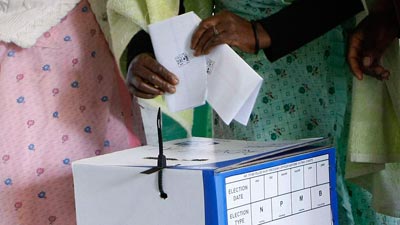The 111 by-elections in municipal wards in 2013 resulted in only two instances where power changed hands – in Tlokwe (Potchefstroom) in the North West and Oudsthoorn in the Western Cape.
By-elections took place in eleven different sessions in all nine provinces. The North West staged the most number of polls (24 or 21.62%), with KwaZulu/Natal coming in second with 18 (16.21%); and the Western Cape playing host to 16 (14.41%) of the by-elections. The Northern Cape and the Free State experienced the least number of by-elections: five each (4.50%). Six (5.40%) wards went uncontested.
Comparatively, only 52 by-elections took place in 2011 and 78 in 2012. The ANC won most of the vacant wards in both years: 77% in 2011 and 69.23% in 2012. Only 18 gains were made in the 111 wards where by-elections took place, with the African National Congress registering the most number of losses and wins respectively.
While the ANC gained six wards from the Democratic Alliance (DA), the Inkatha Freedom Party (IFP), the National Freedom Party (NFP) and Independents, the party suffered eight (7.20%) losses. These concessions mostly benefitted Independents (5), the IFP (1), DA (1) and Pan Africanist Congress (PAC) (1).
Of the five losses ceded to Independents, two were in the North West, while the remaining three were in the Free State, Limpopo and Northern Cape. These wards were won with 50%, 39%, 57%, 49% and 41% of the vote.
In both the Northern Cape and North West wards, candidates — Paul Vries and Butikie Ernest Mahlabe — broke away from the ANC and stood as Independents. While ward 3 in !Kheis, Northern Cape was won with a higher vote than the 51% in the 2011 local elections, ward 26 in the contentious Tlokwe, North West municipality was won with a much lower percentage, 61% compared to 95% in 2011.
Amongst the ANC’s other losses, the PAC made a gain from the party in ward 33 Thulamela, Limpopo; while a former ANC member — Jurie Harmse — delivered ward 13 in the tiny Oudtshoorn municipality to the DA with 54% of the ballot.
Despite the party’s losses, the ANC managed to win 73 of the 111 vacant wards in 2013, a success rate of 65.76%. The DA came second with 29 wards (26.12%).
The DA’s two losses were to the ANC in the Nama Khoi municipality, Northern Cape and in the Witzenberg municipality, Western Cape. In the latter, ward 10 was won by former DA councillor, Piet Waterboer who managed to win 42% of the vote with 50% turnout. Waterboer secured the DA’s win here in the 2011 elections with 48% of the ballot.
Independents lost three wards in 2013. The DA benefitted from this in ward 5, Makhado, Limpopo where former Independent — Miringo Patrick Mazibuko — secured the ward with just 39%, compared to 46% when he won the ward in the 2011 local elections.
The remaining two losses were taken up by the ANC in KwaZulu/Natal and Limpopo. ANC candidate Putina Joel Hlatswayo won ward 20 in Greater Tubatse with 65% and a 19% turnout on the day. Two years before, Independent candidate Willies Pokies Morena had won here with 46% and a 47% voter turnout.
Commenting on the voting patterns in the 2013 by-election cycle, Prof Susan Booysen from Wits University said that these polls again demonstrated that the ANC and DA were the only two parties holding ground.
“What is evident is that the ruling party is ceding little ground to the DA; smaller opposition parties are bearing the brunt of local government politics to the benefit of the ANC and DA to a certain extent,” Booysen said.
Asked about her take on the developments in Tlokwe and the ANC’s subsequent win in the December 11 by-elections, Professor Booysen affirms the ANC is very much “weakened” there.
“Of course, the Tlokwe issue was a big story for 2013. This batch of by-elections illustrated a quite exceptional situation where the governing-party was now weakened; those polls were indeed politically-motivated,” according to Booysen.
The ANC won all six by-elections on December 11 giving the party control of the Tlokwe council. The ANC now has 29-seats in the 52-seat council. The DA-led coalition in comparison has 23-seats.
Another notable council that saw power change hands — albeit for a little while — as a result of by-elections was in Oudtshoorn, a local municipality within the Eden District, Western Cape.
Despite winning ward 13 in the August 7 by-elections and subsequently obtaining a majority on the 25-seat council, the DA alleged that the ANC was frustrating its efforts to govern the municipality effectively.
By November 2013, the DA had sought the help of the courts for a fifth time to regain control of the council. In KwaZulu-Natal’s Nongoma municipality, the National Freedom Party (NFP) strengthened its grip on the 42-seat council by winning two wards off the IFP in the October 23 by-elections. The party now has 21 seats, the IFP 14 and the ANC 7.
PARTY WARDS WON PERCENTAGE GAINS LOSSES ANC 73 65.76% 6
5.40% 8
7.20% DA 29 26.12% 3
2.70% 2
1.80% NFP 2 1.80% 2
1.80% 1
0.90% INDEPENDENT 5 4.50% 5
4.50% 3
2.70% IFP 1 0.90% 1
0.90% 3
2.70% PAC 1 0.90% 1
0.90% 0 MF Totals –
111 –
100% 0
18 1
0.90%
18
SOURCE: www.elections.org.za; SABC News Research & author’s own research
– By Ronesh Dhawraj, senior political researcher


